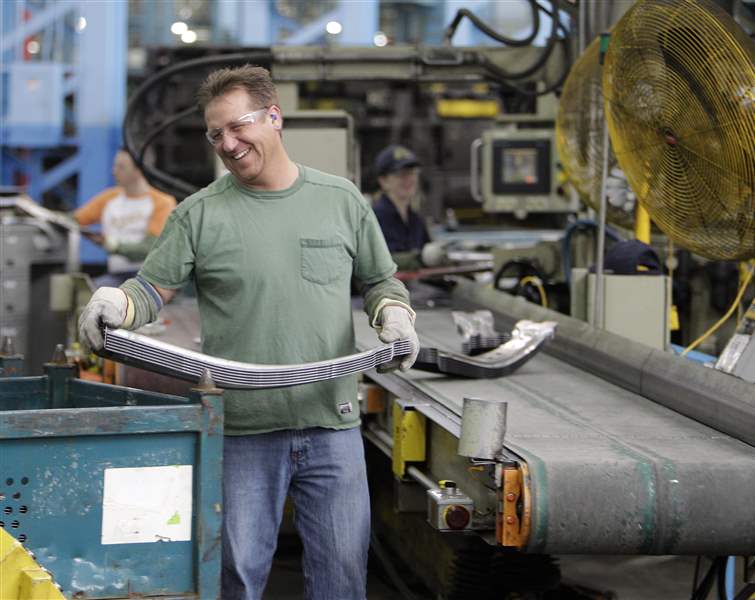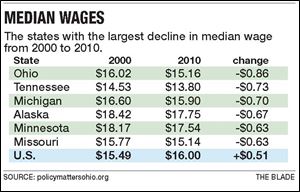
Report says Ohio led U.S. in pay drops in past decade
9/7/2011
An auto worker removes finished parts from a press at General Motors' Parma Metal Center in Parma, Ohio.
ASSOCIATED PRESS
A report from a liberal Cleveland think tank shows Ohio workers had the largest hourly wage cuts in the nation during the past decade.
Policy Matters Ohio says that median hourly wages in the state declined 86 cents to $15.16 in 2010, down from $16.02 in 2000. Ohio was one of only 10 states that had wages decline during that time period, the study shows.
Ohio's manufacturing-based economy took significant hits in the past decade that would have contributed largely to the report's findings, said Amy Hanauer, executive director of Policy Matters and the report's author.
"We're just really not valuing manufacturing," said Ms. Hanauer, whose office is in Cleveland. "Manufacturing is historically what Ohio has been good at, and it's a source of higher-wage jobs."
The study shows Michigan had a 70-cent wage decline to $15.90 an hour in 2010 from $16.60 in 2000.
Although Michigan's wages declined more slowly than Ohio's, Ms. Hanauer said Michigan lost more jobs.
Other states that lost income in the past decade included Tennessee, Alaska, Minnesota, Missouri, Illinois, South Carolina, Indiana, and Iowa. Nationally, median hourly wages increased 51 cents to $16 in 2010 from $15.49 in 2000.

Matt Mayer, president of the Buckeye Institute, a conservative research group in Columbus, said states that experienced wage losses may have been affected by union influence.
"It's not a surprise to me that seven out of 10 are in forced unionization states," Mr. Mayer said. "States that protect the rights of workers have much stronger job figures."
Along with declining pay, Policy Matters paints a rather bleak picture of Ohio's economy in the last 10 years. The state lost 594,000 jobs since its peak employment levels more than 10 years ago. And, the study shows, the percentage of Ohio's population that is working or looking for work fell for the fourth straight year to 65.2 percent.
Gbenga Ajilore, an associate professor of economics at the University of Toledo, said Ohio's losses probably are tied to the decline of manufacturing businesses in the state. Other states tend to have more service-sector companies, which are more likely to hire and offer more pay after a recession.
"The big thing is, when you lose manufacturing jobs, those jobs aren't coming back," he said.
Bruce Baumhower, president of United Auto Workers Local 12, said global competition and increasing health-care costs also have put pressure on manufacturers to lower wages in recent years.
For instance, the union represents about 250 employees of a Johnson Controls auto supplier plant in Northwood, who agreed to lower starting wages several years ago to win a contract to make vehicle seats. The work was nearly outsourced later to a plant in India, but local Johnson Controls workers implemented productivity improvements that allowed the Toledo-area facility to keep the work.
"Globalization has had a huge impact on the downward spiral of wages because we're competing with companies that are paying $1.50 to $4.50 an hour between Asia and Mexico," Mr. Baumhower said.
Many employers, he said, have tried to shoulder a portion of skyrocketing health insurance costs in the last decade, a cost that he believes has made it difficult for some companies to increase pay.
"We've tried to bargain those benefits sometimes in lieu of wage increases," Mr. Baumhower said.
Ms. Hanauer said a two-tier wage system at automotive and supplier plants in the state, under which new employees are making $14 or $15 an hour -- about half of what veteran employees receive -- could make it a challenge for Ohio wages to increase during the next decade.
Mr. Ajilore and Ms. Hanauer said metro Toledo's and Ohio's economy could benefit from the growth of companies outside of traditional manufacturing, such as solar panel production.
"If that explodes and it becomes a big industry, you'll see higher wages because there will be a demand for technology," Mr. Ajilore said.
Contact Sheena Harrison at: sharrison@theblade.com or 419-724-6103.